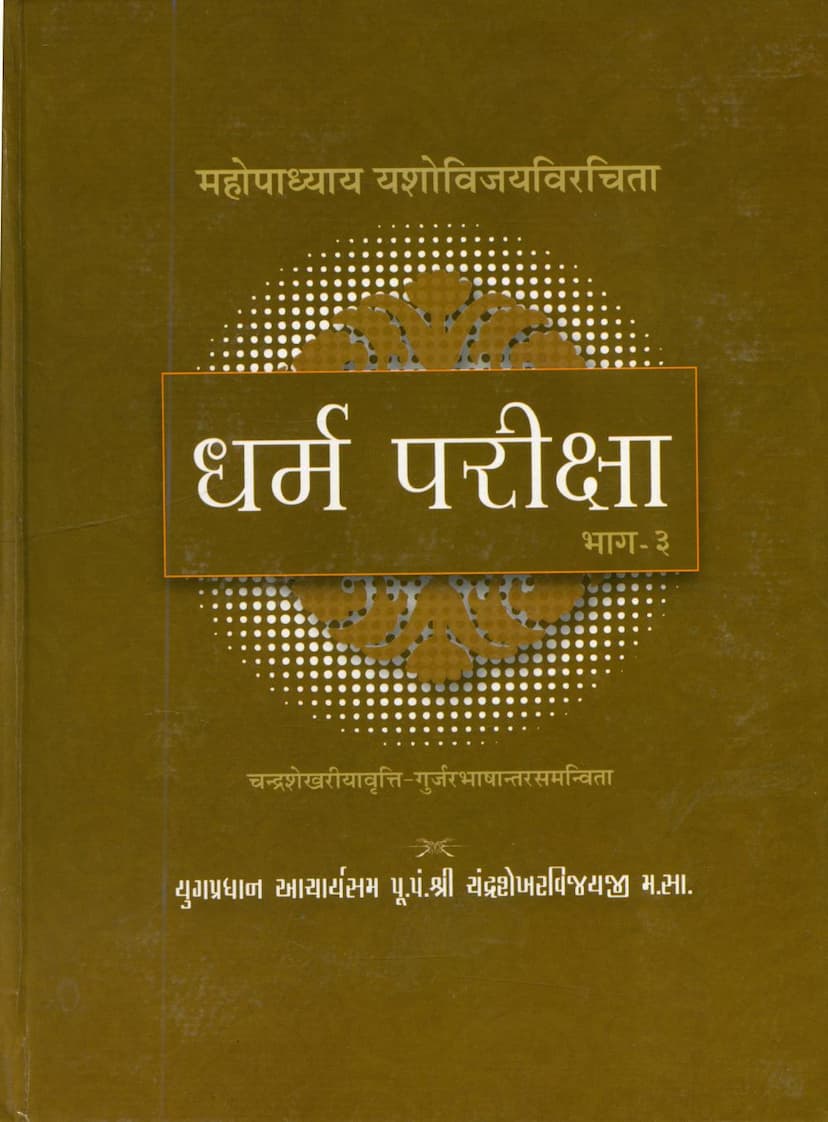Dharm Pariksha Part 03
Added to library: September 1, 2025

Summary
This document is "Dharm Pariksha Part 03" authored by Chandrashekharvijay, published by Kamal Prakashan Trust. It is a commentary and Gujarati translation of the original work by Mahamahopadhyay Yashovijayji.
Here's a summary of the key themes and arguments presented in the provided pages:
Core Argument: The text delves into the nuances of Jain philosophy, particularly focusing on the concept of Samyaktva (Right Faith) and how individuals, including those with differing beliefs, can progress towards it. A central theme is the "Dharm Pariksha" (Test of Dharma) itself, which is about discerning the true path.
Key Concepts and Discussions:
-
Samyaktva and its Foundation:
- Samyaktva is defined as having faith in Arihants as the true deities (Sudev), those who follow the Panchamhavratas (Jain ascetics) as the true gurus (Suguru), and Jainism as the true religion (Sudharma).
- It's based on firm conviction in these three principles. A true Samyagdarshi (one with right faith) will not bow to or worship anyone other than Arihants, nor consider non-Jain ascetics as true gurus, nor accept other religions as true dharma.
- This conviction is not blind faith or personal attachment but a result of understanding and testing.
-
The Analogy of the Patient and the Doctor:
- The text uses a powerful analogy of a patient recovering from illness. A wise patient, after trying various doctors, will stick with the one whose diagnosis and medicine are effective. This isn't personal liking but a rational choice based on results.
- Similarly, a discerning soul examines various religious paths and their exponents, ultimately choosing the one that leads to true liberation (Moksha) as demonstrated by the Arihants (Vitaraag Dev).
-
Types of Misconceptions (Mithyatva) and their Graded Nature:
- The text discusses different types of Mithyatva, including:
- Abhigrahik Mithyatva: Blind adherence to one's own beliefs without proper examination.
- Abhiniveshik Mithyatva: Obstinate attachment to one's views.
- Sanshayik Mithyatva: Doubt and uncertainty about principles.
- Anabhog Mithyatva: Unintentional or ignorant wrong belief.
- It differentiates between these types, classifying some as more severe (Guru) and others as less severe (Laghu) based on their consequences and the potential for correction.
- The text discusses different types of Mithyatva, including:
-
The Role of "Anekantavada" and Tolerance in Early Stages:
- The text emphasizes that for those new to spiritual paths or those who are inherently neutral ("Madhystha Mithyatvi"), an initial tolerance towards various paths and deities is acceptable.
- This is presented as a strategic approach to guide them gently towards the right path. Forcing them to renounce other beliefs immediately could backfire and alienate them.
- The analogy is drawn of introducing a third, correct medicine to a patient already taking two less effective ones, rather than forbidding the existing ones outright.
-
Reconciling Differences and the Concept of "Samyak Kriya":
- The text addresses the apparent contradictions between different spiritual traditions (e.g., teachings of Buddha, Kapil, and Mahavir). It suggests that these differences might arise from adapting teachings to the audience's understanding or specific context.
- It introduces the idea of "Samyak Kriya" (right action), which, when performed with pure intention and understanding, can lead towards the right path, even if the external form of the action might seem similar across different traditions initially.
-
The Importance of "Abhipraay" (Intention/Understanding) and "Naya" (Perspectives):
- The text highlights that the true essence of a practice lies in the underlying intention and understanding. Different "Nay" (philosophical standpoints or perspectives) can lead to different interpretations, but the ultimate goal of liberation remains the same.
- It stresses that criticizing other traditions without understanding their deeper intentions is not advisable.
-
The Path of Progress: Yoga Drishti:
- The text describes a progression of spiritual understanding through "Yoga Drishti" (perspectives of Yoga), categorized into four stages: Mitra (Friend), Tara (Star), Bala (Strength), and Deepa (Light).
- Each stage is characterized by increasing clarity of understanding, detachment from worldly desires, and progress in spiritual practices, ultimately leading towards right faith and liberation.
-
The Role of "Marganusarita" (Following the Path):
- The text emphasizes that "Marganusarita" is the true indicator of adherence to the path and a sign of adherence to divine commandments.
- It argues that actions themselves are not always the sole determinant of Marganusarita. Internal understanding, intention, and the ultimate benefit derived are crucial. The path should be followed with genuine understanding and sincerity, not just mechanical adherence.
-
The Concept of "Bhava Jainatva" (Inner Jainness):
- It is argued that even those from other traditions, if they possess certain qualities like a sincere desire for truth, detachment, and adherence to righteous principles (even if not strictly Jain rituals), can be considered to have "Bhava Jainatva" (inner Jainness). This is because their underlying pursuit aligns with the core principles of the Jain path.
-
The Ultimate Goal: Sarvajna (Omniscient Beings):
- The text discusses the Jain concept of Sarvajnas (omniscient beings), emphasizing that while there are numerous omniscient beings in Jainism, their knowledge is identical. The focus is on the devotion and practice, not just the specific omniscient being worshipped.
- It also addresses how other traditions view their omniscient figures and attempts to reconcile these views within a broader spiritual framework, suggesting that the underlying pursuit of truth and liberation might share common ground.
Overall Message: The text promotes a comprehensive and inclusive understanding of spiritual progress. It advocates for rational inquiry, the importance of right faith stemming from understanding, and a gradual approach to spiritual evolution. It acknowledges that different paths might have different methods, but the ultimate goal of liberation and the underlying principles of righteousness, non-violence, and truth are universal. The commentary, "Chandrashekharia Vritti," aims to clarify and illuminate these profound concepts for a Gujarati-speaking audience.